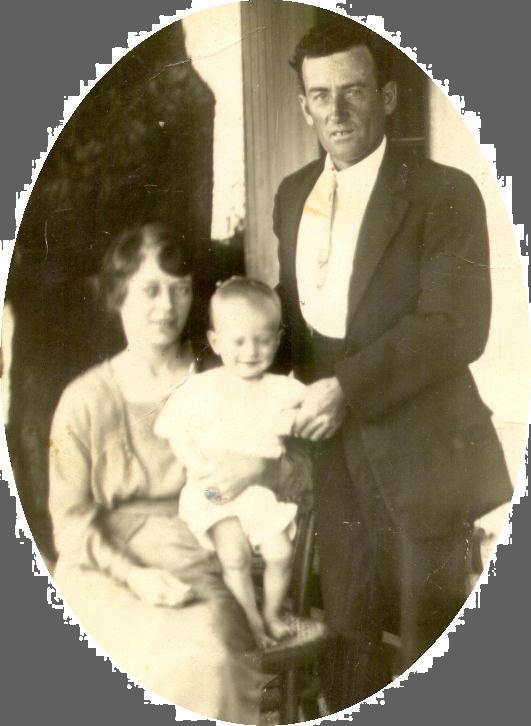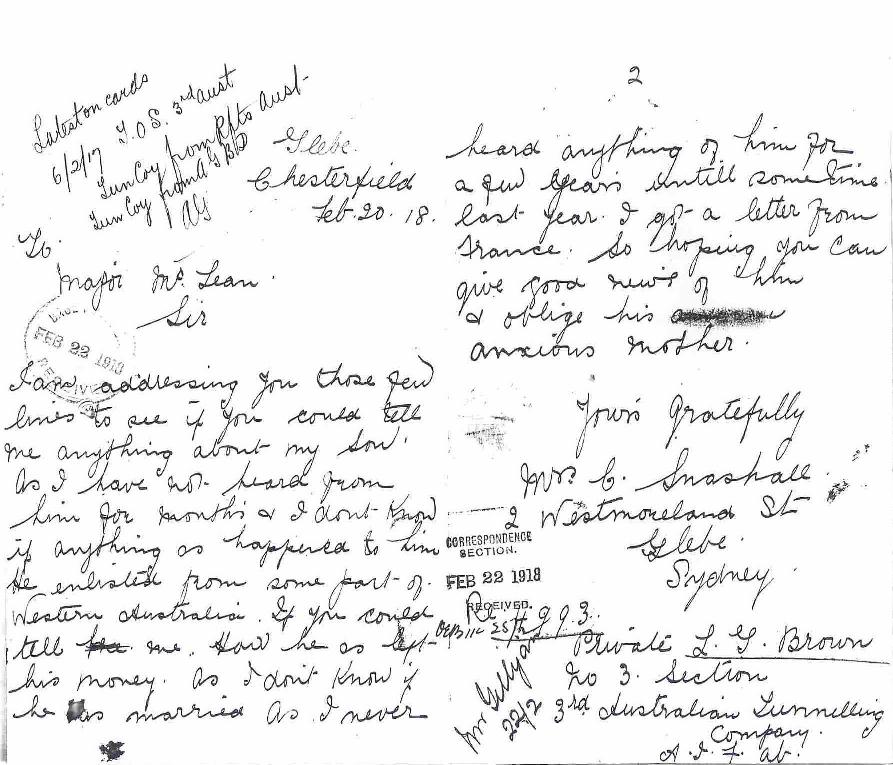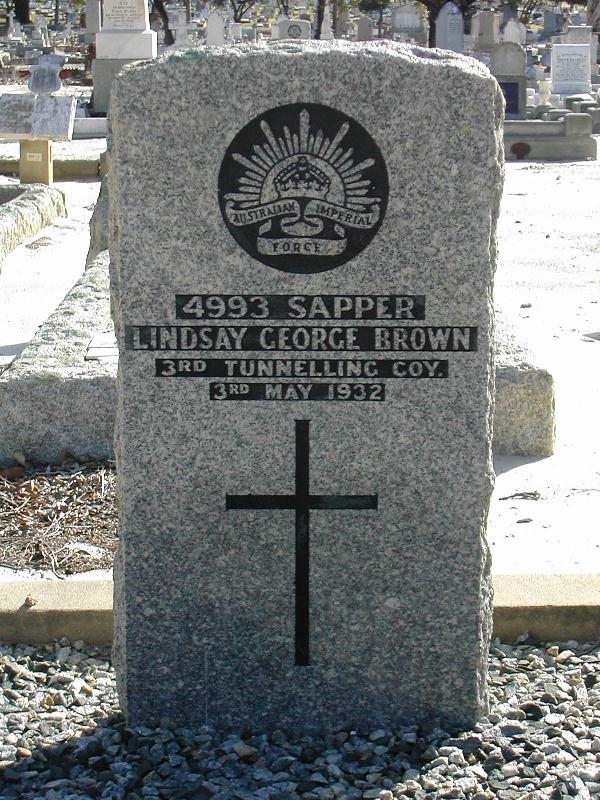|
Trevor's Paternal Grandparents
Lindsay Murdock Graham Snushall was born in Cobar NSW on the 17th May 1889 to George Snushall (Blacksmith) and Catherine Josephine Cassidy . Lindsay was the 4th of 9 children, though one of his sisters, Ida, died at or shortly after birth. All of the children were born in NSW. George, Catherine and their younger children moved to live in Western Australia some time after the birth of Lindsay's youngest sister, Ada Alma Snashall, who was born in Bathurst NSW about 1899. Obituaries for Lindsay's Grandmother, Bridget Cassidy (b.1837-d.1906), and his Uncle, Michael Cassidy (b.1861-d.1915), both indicate that Catherine Snushall was living in Western Australia at those times. . Lindsay was the 4th of 9 children, though one of his sisters, Ida, died at or shortly after birth. All of the children were born in NSW. George, Catherine and their younger children moved to live in Western Australia some time after the birth of Lindsay's youngest sister, Ada Alma Snashall, who was born in Bathurst NSW about 1899. Obituaries for Lindsay's Grandmother, Bridget Cassidy (b.1837-d.1906), and his Uncle, Michael Cassidy (b.1861-d.1915), both indicate that Catherine Snushall was living in Western Australia at those times.
But I'm jumping ahead too quickly! My Grandfather was certainly an interesting person and whilst researching him I was intrigued to learn of a number of discrepancies that cannot be easily explained away.
His family always knew my Grandfather as Lindsay George Brown and I have found no evidence that his own family were ever aware that he was born Lindsay Murdock Graham Snushall. He died in Western Australia in 1932, many years before any of his 44 grandchildren were born, and it wasn't until I took an interest in 2003 that I got to know anything at all about him, nor had I ever seen a photograph of him. It was William Harold Brown, Lindsay's youngest and sole surviving son, who explained to me that his Father had died when Uncle Harold was only 6-months old, and I was delighted when Harold sent me a photograph of my Grandparents holding their first child, my father George Brown.
During WWI, Lindsay enlisted in the Army (AIF) on 17 January 1916. He enlisted at Blackboy Hill in WA, though it seems that he was working in Kalgoorlie up to that time because that is where he had his medical two days earlier. Lindsay enlisted as a single man and nominated a Mr. Jack Griffith of Kalgoorlie as his next-of-kin. At the time of enlisting into the Army, Lindsay had changed his name to Lindsay George Brown and maintained this name until his death in 1932.
When he enlisted, Lindsay gave his occupation as being a Miner and was posted to 6th Australian Tunnelling Company. It was the Australian Tunnelling Company's responsibility to construct tunnels across "no-man's land" that separated the opposing forces, and further until they were under German Pill-boxes or troop concentrations. Then they would lay stockpiles of explosives in the mineshaft to destroy the enemy above. They were also responsible to keep intact the mines/tunnels that had been laid. Much of this protection involved fighting underground.
No doubt due to his age and mining experience, Lindsay was rapidly promoted from Private to Sapper (10/3/16) and to Cpl (2/5/16). His company shipped to England on 1/6/16 on the "Warilda". They were then shipped o/s to France on 28/8/16. Soon after his arrival in France he was transferred to 3rd Australian Tunnelling Company on the 30/9/16 following disbandment of the 6th ATC. Within months of this transfer he was wounded in action by poison gas whilst underground, on 27/11/16. (The chemicals used in Gas Warfare in WWI by the British, French & Germans were initially chlorine or phosgene. Chlorine attacks the respiratory system; phosgene also attacks the eyes).
This action was recorded by the official WWI Historian, C.W. Bean:-
The 3rd Australian Tunnelling Company, a Western Australian unit with a proportion of Tasmanians, had taken part in the Battle of Fromelles. In November 1916 it was ordered to extend its activity southward to include the mines at Hill 70 where the Germans were mining actively and aggressively. In taking their first steps to fight down the enemy the Australians had to work to a large extent in the dark. This led to immediate disaster. On November 27th, when a mine had been charged and was about to be tamped for explosion, the Germans blew a "camouflet", which exploded the Australian's charge, killing 20 miners and gassing an officer and 8 other ranks.
Lindsay was discharged from hospital on 6/2/17 and returned to his unit, the 3rd Australian Tunnelling Company. After that time, he returned to hospital on a number of occasions over the following two years (during 1917 & 1918) suffering Bronchitis and Fibrosis of the Lungs, before being returned to Australia on the "Nevasa" on 5/3/19. Lindsay was discharged from the Army on 7/6/19. He was awarded the 1914-15 Star, the British War Medal and the Victory Medal.
The following year after his discharge my grandparents married. My Grandmother, Margaret Ellen (Nell) McGlenchy, was born in Ballarat Victoria in 1903 to John & Agatha Evelyn McGlenchy (nee Jenkins). John McGlenchy was a miner who probably worked the gold mines at Ballarat. (By coincidence, my wife's Great, Great Grandfather, John Dunlop and his mate James Regan, were credited with the discovery of gold at Ballarat, at a place called Poverty Hill, in 1851).
Lindsay's Army Service Records included two letters written by Catherine Snashall who claimed to be the mother of Lindsay George Brown and was seeking information about his well-being. Catherine's letters to the Army made it appear conclusive that Lindsay George Brown was her child. A typical response from living Snushall descendants upon learning that Lindsay George Brown was in fact Lindsay Murdock Graham Snushall, was from a grandson of William Harold Snashall, who was a lawyer and wrote: "It would appear to be conclusive to me that he was the son of Catherine in light of her letters which also make reference to his letter to her".
 |
Catherine's 1st Letter
A Copy of the Second Letter to be found in the Documents section
As you attempt to put together some sort of family history, the fact that my Grandfather's occupations were Blacksmith, Miner and Mine Carpenter, meant that the family lived in or near mining towns. As mentioned, Nell's own Father, John McGlenchy, was also a Miner and his family were living in Cue which was a wealthy, thriving gold mining town where Nell met Lindsay who, at that time worked as a Blacksmith. This was recorded on their Wedding Certificate a few months later. Lindsay and Nell were married in Geraldton WA, a large regional town not far from Cue. My Father's birth certificate shows they married on the 13th April 1920. The Marriage Record shows it was the 20th April 1920. Early in their marriage, our Grandparents continued to live & work in Cue where my Father was born later in 1920. Most of their other children were born in Yalgoo, approx 150 kms from Cue, which was another thriving gold mining town where gold was discovered in 1892.
The family then moved to live in Collie where their youngest child, Harold, was born in 1931. Collie is a coal-mining town. No doubt it was while working in these mines that Lindsay contracted Anthracosis of the lungs, which was to kill him. This condition, is commonly known as "Black Lung" disease, and is caused by the inhalation of coal dust, typically affecting older coal miners over the age of 50.
Lindsay died 3rd May 1932. His Death Certificate says he was 38 but that was based on the error that he was born on 17 May 1893. Lindsay was in fact born on 17 May 1889 and would have been 42 (only days off 43) when he died.
 Lindsay's relatively early death at age 42 was no doubt due to his damaged lungs caused by poison gas in France during WWI, which supports Uncle Harold's belief that his Father's death was at least in part due to his war injuries. Nell, Lindsay and their seven young children were still living in Collie when Lindsay died on 3rd May 1932 and is buried in the Presbyterian section at Karrakatta Cemetery. Lindsay's relatively early death at age 42 was no doubt due to his damaged lungs caused by poison gas in France during WWI, which supports Uncle Harold's belief that his Father's death was at least in part due to his war injuries. Nell, Lindsay and their seven young children were still living in Collie when Lindsay died on 3rd May 1932 and is buried in the Presbyterian section at Karrakatta Cemetery.
Lindsay is buried in the Presbyterian section at Karrakatta Cemetery. The simple grave is marked with an AIF Memorial, shown here. I received the following reply when I queried the status of his grave site, which I had found to have expired:-
"Your grandfather Lindsay George Brown is buried in the Presbyterian section FA/0259 as you have found on our website. The Presbyterian section is part of Karrakatta Cemetery and has nothing to do with the War Cemetery. The War Cemetery is administered by the Commonwealth Government and is completely separate from the Metropolitan Cemeteries Board. This Presbyterian area is due for redevelopment in the next 10-15 years and therefore the grant cannot be renewed. The existing graves and the remains are not disturbed when redeveloping takes place, but headstones and anything above the ground is removed, unless the grave is being "retained" by the Board. This is at the discretion of the Board and a panel of Historical members. The areas between the existing graves, the pathways, then become the new graves.
The Funeral Notice, published in the West Australian newspaper, shows that at the time of Lindsay's death the family were not aware that his parents were named Snushall. His parents were described as Mr and Mrs George Brown. However, it does show that Lindsay was regarded as a fond brother of Maud Attwood. Lindsay's older sister, Maude Ada Ethell Victoria Snushall, was born in 1887. She married Norman Leslie Attwood in 1904. This reference to his sister is the only known indication that Lindsay ever kept in contact with his extended family after his time in the Army during WWI.
Grandma went on to lead a full life for another 39 years. She married Hawley Gardiner at Perth in 1942. Although she was living at Mount Barker at the time, she died on 12th January 1971 whilst at Perth visiting her daughter, Aunty Billie. She is buried in the Anglican section of the Karrakatta Cemetery; site PC/0669.
Children of Lindsay and Margaret Brown:
George (1920-1962)
Edward John (Johnny) (1921-1942)
Douglas Vivien (Tom) (1923-1991)
Dorothy (Topsy) Joan (1926-1991)
Margaret (Peggy) Evelyn (1927-1981)
Noreen (Billy) A. (1929-?)
William Harold (1931-2004)
|
|